张季跃 201771010139《面向对象程序设计(java)》第十一周学习总结
张季跃 201771010139《面向对象程序设计(java)》第十一周学习总结
第一部分:理论知识学习部分
一.数据结构:
- 一般将数据结构分为两大类:
(1)线性数据结构:线性表、栈、队列、串、数组和文件。
(2)非线性数据结构:树和图。
- 线性表:l
(1)线性表的逻辑结构是n个数据元素的有限序列: (a1,a 2,a3,…an) n为线性表的长度(n≥0),n=0的表称为空表。 l
(2)数据元素呈线性关系:必存在唯一的称为“第一 个”的数据元素;必存在唯一的称为“后一个 ”的数据元素;除第一个元素外,每个元素都有 且只有一个前驱元素;除后一个元素外,每个 元素都有且只有一个后继元素。 l
(3)所有数据元素在同一个线性表中必须是相同的数 据类型。
(4)线性表按其存储结构可分为顺序表和链表
(5)用顺序存储结构存储的线性表称为 顺序表 ;
(6)顺序表将线性表中的数据元素依次存放在某个存储区域中。 一维数组 就是用顺序方式存储的线性表。
(7)用链式存储结构存储的线性表称为链表 。
- 栈:
l(1)栈(Stack)也是一种特殊的 线性表,是一种后进先出 (LIFO)的结构。 l
(2)栈是限定仅在表尾进行插入 和删除运算的线性表,表尾 称为栈顶(top),表头称为 栈底(bottom)。 l
(3)栈的物理存储可以用顺序存 储结构,也可以用链式存储 结构
- 队列:
(1)队列(Queue)是限定所有的插入只能在表的一端进行 ,而所有的删除都在表的另一端进行的线性表。 l
(2)表中允许插入的一端称为队尾(Rear),允许删除的一端称为队头(Front)。 l
(3)队列的操作是按先进先出(FIFO)的原则进行的。 l
(4)队列的物理存储可以用顺序存储结构,也可以用链 式存储结构
- 散列表:
(1)散列表又称为哈希表。散列表算法的基本思想是:以结点 的关键字为自变量,通过一定的函数关系(散列函数)计 算出对应的函数值,以这个值作为该结点存储在散列表中的地址。 l
(2)当散列表中的元素存放太满,就必须进行再散列,将产生 一个新的散列表,所有元素存放到新的散列表中,原先的 散列表将被删除。在Java语言中,通过负载因子(load factor)来决定何时对散列表进行再散列。例如:如果负载 因子是0.75,当散列表中已经有75%的位置已经放满,那么 将进行再散列。 l
(3)负载因子越高(越接近1.0),内存的使用效率越高,元素的 寻找时间越长。负载因子越低(越接近0.0),元素的寻找时 间越短,内存浪费越多。
(4)HashSet类的缺省负载因子是0.75。
二.JAVA的集合框架:
- 集合框架:
(1)JAVA的集合框架实现对各种数据结构的封装,以 降低对数据管理与处理的难度。 l
(2)所谓框架就是一个类库的集合,框架中包含很多 超类,编程者创建这些超类的子类可较方便的设 计设计程序所需的类。例如:Swing类包 l
(3)集合(Collection或称为容器)是一种包含多个元素 并提供对所包含元素操作方法的类,其包含的元 素可以由同一类型的对象组成,也可以由不同类 型的对象组成。 l
(4)集合框架:JAVA集合类库的统一架构。
- 集合类的作用:
(1)l集合类的作用: –Java的集合类提供了一些基本数据结构的支持。 –例如Vector、Hashtable、Stack等。
(2)集合类的使用: –Java的集合类包含在java.util包中。 –import java.util.*;
- 集合类的特点
(1)–只容纳对象。 注意:数组可以容纳基本数据类型数据和对象。 –如果集合类中想使用基本数据类型,又想利用 集合类的灵活性,可以把基本数据类型数据封 装成该数据类型的包装器对象,然后放入集合 中处理
(2)–集合类容纳的对象都是Object类的实例,一旦 把一个对象置入集合类中,它的类信息将丢失 ,这样设计的目的是为了集合类的通用性。 –因为Object类是所有类的祖先,所以可以在这 些集合中存放任何类的对象而不受限制,但切 记在使用集合成员之前必须对它重新造型
- 新旧集合类:
(1)l在JDK1.0和JDK1.1中提供了Vector(矢量), Hashtable(哈希表),Stack(堆栈), Properties(属性集)等集合类,尽管这些类非 常有用,但却彼此独立,缺少一个统一集中的机 制。 l
(2)在JDK1.2中,JAVA设计了一个统一的类集,并 对上述类进行了改写,使其统一纳入JAVA的集 合框架
三.JDK1.1版本中的集合类:
- Vector:
(1)lVector类类似长度可变的数组。 l
(2)Vector中只能存放对象。 l
(3)Vector的元素通过下标进行访问。 l
(4)Vector类关键属性: –capacity表示集合多能容纳的元素个数。 –capacityIncrement表示每次增加多少容量。 –size表示集合当前元素个数
- Stack:
(1)lStack类是Vector的子类。 l
(2)Stack类描述堆栈数据结构,即LIFO。 l
(3)Stack类的关键方法: –public void push(Object item) //把项压入栈顶
–public Object pop()//移除栈顶对象并作为此函数的值返回该对象
–public Object peek()//查看栈顶对象而不移除它
–public boolean empty()//测试堆栈是否为空
- Hashtable:
(1)lHashtable通过键来查找元素。
(2)Hashtable用散列码(hashcode)来确定键。所 有对象都有一个散列码,可以通过Object类的 hashCode()方法获得
四.JDK1.2以后版本中的集合类:
- Collection :
集合层次中的根接口,JDK未提供这个 接口的直接实现类。
- List:
是一个有序的集合,可以包含重复的元素。提 供了按索引访问的方式。
- Set :
不能包含重复的元素。对象可能不是按存放的 次序存放,也就是说不能像数组一样按索引的方式进 行访问,SortedSet是一个按照升序排列元素的Set。
- Map:
包含了key-value对。Map不能包含重复的key 。 lSortedMap是一个按照升序排列key的Map
第二部分:实验部分
1、实验目的与要求
(1) 掌握Vetor、Stack、Hashtable三个类的用途及常用API;
(2) 了解java集合框架体系组成;
(3) 掌握ArrayList、LinkList两个类的用途及常用API。
(4) 了解HashSet类、TreeSet类的用途及常用API。
(5)了解HashMap、TreeMap两个类的用途及常用API;
(6) 结对编程(Pair programming)练习,体验程序开发中的两人合作。
2、实验内容和步骤
实验1: 导入第9章示例程序,测试程序并进行代码注释。
测试程序1:
l 使用JDK命令运行编辑、运行以下三个示例程序,结合运行结果理解程序;
l 掌握Vetor、Stack、Hashtable三个类的用途及常用API。
测试程序1:
import java.util.Vector;
class Cat {
private int catNumber;
Cat(int i) {
catNumber = i;
}
void print() {
System.out.println("Cat #" + catNumber);
}
}
class Dog {
private int dogNumber;
Dog(int i) {
dogNumber = i;
}
void print() {
System.out.println("Dog #" + dogNumber);
}
}
public class CatsAndDogs {
public static void main(String[] args) {
Vector cats = new Vector();
for (int i = 0; i < 7; i++)
cats.addElement(new Cat(i));
cats.addElement(new Dog(7));
for (int i = 0; i < cats.size(); i++)
((Cat) cats.elementAt(i)).print();
}
}
测试结果:

修改测试程序1:
import java.util.Vector;
class Cat {
private int catNumber;
Cat(int i) {
catNumber = i;
}
void print() {
System.out.println("Cat #" + catNumber);
}
}
class Dog {
private int dogNumber;
Dog(int i) {
dogNumber = i;
}
void print() {
System.out.println("Dog #" + dogNumber);
}
}
public class CatsAndDogs {
public static void main(String[] args) {
Vector cats = new Vector();
for (int i = 0; i < 7; i++)
cats.addElement(new Cat(i));
cats.addElement(new Dog(7));
for (int i = 0; i < cats.size(); i++) {
if (cats.elementAt(i) instanceof Cat) {
((Cat) cats.elementAt(i)).print();
}else {
((Dog) cats.elementAt(i)).print();
}
}
}
}
测试结果(改):
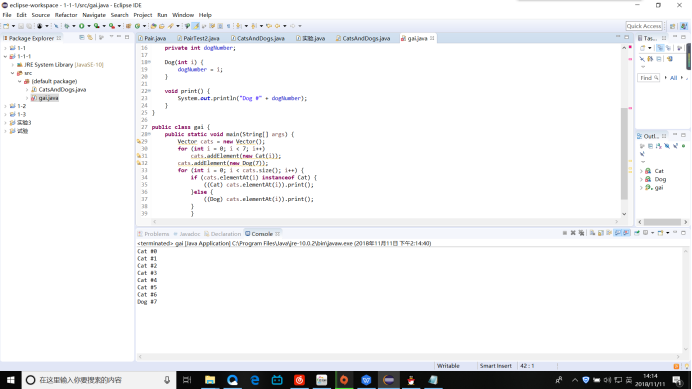
测试程序2:
import java.util.*;
public class Stacks {
static String[] months = { "1", "2", "3", "4" };
public static void main(String[] args) {
Stack stk = new Stack();
for (int i = 0; i < months.length; i++)
stk.push(months[i]);
System.out.println(stk);
System.out.println("element 2=" + stk.elementAt(2));
while (!stk.empty())
System.out.println(stk.pop());
}
}
测试结果:
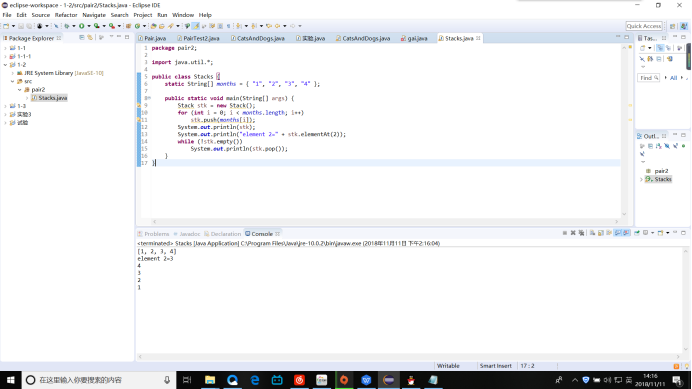
测试程序3:
import java.util.*;
class Counter {
int i = 1;
public String toString() {
return Integer.toString(i);
}
}
public class Statistics {
public static void main(String[] args) {
Hashtable ht = new Hashtable();
for (int i = 0; i < 10000; i++) {
Integer r = new Integer((int) (Math.random() * 20));
if (ht.containsKey(r))
((Counter) ht.get(r)).i++;
else
ht.put(r, new Counter());
}
System.out.println(ht);
}
}
测试结果:
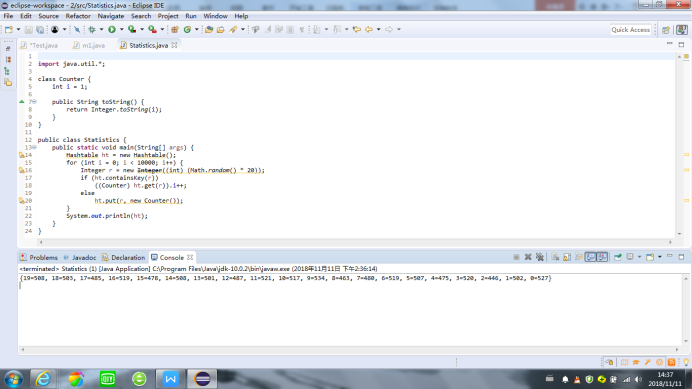
测试程序2:
l 使用JDK命令编辑运行ArrayListDemo和LinkedListDemo两个程序,结合程序运行结果理解程序;
l 在Elipse环境下编辑运行调试教材360页程序9-1,结合程序运行结果理解程序;
l 掌握ArrayList、LinkList两个类的用途及常用API。
ArrayListDemo:
import java.util.*;
public class ArrayListDemo {
public static void main(String[] argv) {
ArrayList al = new ArrayList();
// Add lots of elements to the ArrayList...
al.add(new Integer(11));
al.add(new Integer(12));
al.add(new Integer(13));
al.add(new String("hello"));
// First print them out using a for loop.
System.out.println("Retrieving by index:");
for (int i = 0; i < al.size(); i++) {
System.out.println("Element " + i + " = " + al.get(i));
}
}
}
测试结果:
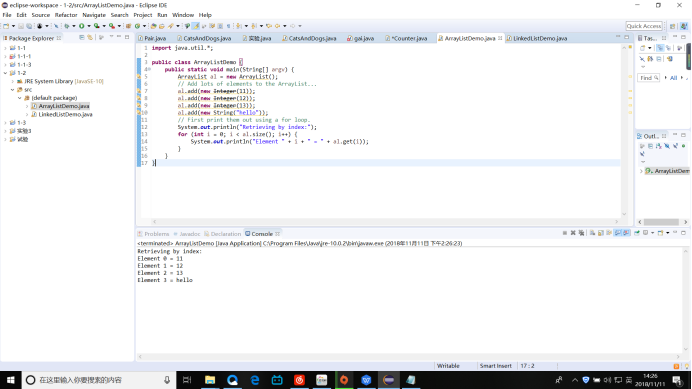
LinkedListDemo:
import java.util.*;
public class LinkedListDemo {
public static void main(String[] argv) {
LinkedList l = new LinkedList();
l.add(new Object());
l.add("Hello");
l.add("zhangsan");
ListIterator li = l.listIterator(0);
while (li.hasNext())
System.out.println(li.next());
if (l.indexOf("Hello") < 0)
System.err.println("Lookup does not work");
else
System.err.println("Lookup works");
}
}
测试结果:
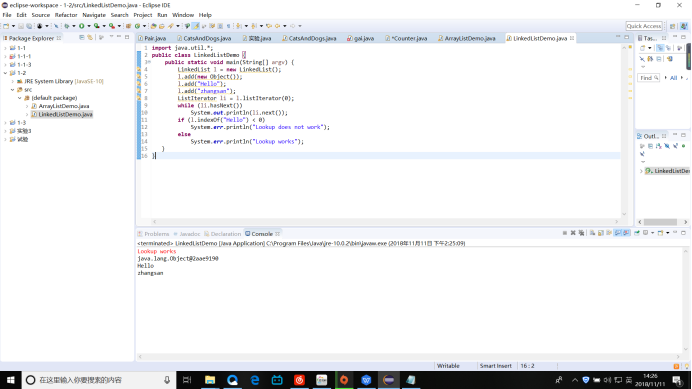
程序9-1:
package linkedList;
import java.util.*;
/**
* This program demonstrates operations on linked lists.
* @version 1.11 2012-01-26
* @author Cay Horstmann
*/
public class LinkedListTest
{
public static void main(String[] args)
{
List<String> a = new LinkedList<>();
a.add("Amy");
a.add("Carl");
a.add("Erica");
List<String> b = new LinkedList<>();
b.add("Bob");
b.add("Doug");
b.add("Frances");
b.add("Gloria");
// merge the words from b into a
ListIterator<String> aIter = a.listIterator();
Iterator<String> bIter = b.iterator();
while (bIter.hasNext())
{
if (aIter.hasNext()) aIter.next();
aIter.add(bIter.next());
}
System.out.println(a);
// remove every second word from b
bIter = b.iterator();
while (bIter.hasNext())
{
bIter.next(); // skip one element
if (bIter.hasNext())
{
bIter.next(); // skip next element
bIter.remove(); // remove that element
}
}
System.out.println(b);
// bulk operation: remove all words in b from a
a.removeAll(b);
System.out.println(a);
}
}
测试结果:
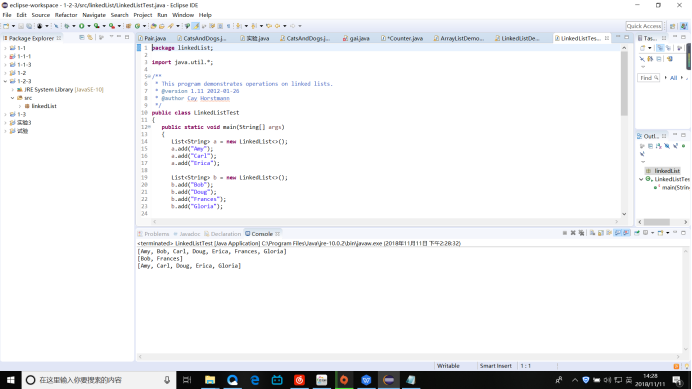
测试程序3:
l 运行SetDemo程序,结合运行结果理解程序;
l 在Elipse环境下调试教材365页程序9-2,结合运行结果理解程序;了解HashSet类的用途及常用API。
l 在Elipse环境下调试教材367页-368程序9-3、9-4,结合程序运行结果理解程序;了解TreeSet类的用途及常用API。
测试程序SetDemo:
import java.util.*;
public class SetDemo {
public static void main(String[] argv) {
HashSet h = new HashSet(); //也可以 Set h=new HashSet()
h.add("One");
h.add("Two");
h.add("One"); // DUPLICATE
h.add("Three");
Iterator it = h.iterator();
while (it.hasNext()) {
System.out.println(it.next());
}
}
}
测试结果:

程序9-2:
package set;
import java.util.*;
/**
* This program uses a set to print all unique words in System.in.
* @version 1.12 2015-06-21
* @author Cay Horstmann
*/
public class SetTest
{
public static void main(String[] args)
{
Set<String> words = new HashSet<>(); // HashSet implements Set
long totalTime = 0;
try (Scanner in = new Scanner(System.in))
{
while (in.hasNext())
{
String word = in.next();
long callTime = System.currentTimeMillis();
words.add(word);
callTime = System.currentTimeMillis() - callTime;
totalTime += callTime;
}
}
Iterator<String> iter = words.iterator();
for (int i = 1; i <= 20 && iter.hasNext(); i++)
System.out.println(iter.next());
System.out.println(". . .");
System.out.println(words.size() + " distinct words. " + totalTime + " milliseconds.");
}
}
程序9-3、9-4:
package treeSet;
import java.util.*;
/**
* An item with a description and a part number.
*/
public class Item implements Comparable<Item>
{
private String description;
private int partNumber;
/**
* Constructs an item.
*
* @param aDescription
* the item's description
* @param aPartNumber
* the item's part number
*/
public Item(String aDescription, int aPartNumber)
{
description = aDescription;
partNumber = aPartNumber;
}
/**
* Gets the description of this item.
*
* @return the description
*/
public String getDescription()
{
return description;
}
public String toString()
{
return "[description=" + description + ", partNumber=" + partNumber + "]";
}
public boolean equals(Object otherObject)
{
if (this == otherObject) return true;
if (otherObject == null) return false;
if (getClass() != otherObject.getClass()) return false;
Item other = (Item) otherObject;
return Objects.equals(description, other.description) && partNumber == other.partNumber;
}
public int hashCode()
{
return Objects.hash(description, partNumber);
}
public int compareTo(Item other)
{
int diff = Integer.compare(partNumber, other.partNumber);
return diff != 0 ? diff : description.compareTo(other.description);
}
}
package treeSet;
import java.util.*;
/**
* This program sorts a set of item by comparing their descriptions.
* @version 1.12 2015-06-21
* @author Cay Horstmann
*/
public class TreeSetTest
{
public static void main(String[] args)
{
SortedSet<Item> parts = new TreeSet<>();
parts.add(new Item("Toaster", 1234));
parts.add(new Item("Widget", 4562));
parts.add(new Item("Modem", 9912));
System.out.println(parts);
NavigableSet<Item> sortByDescription = new TreeSet<>(
Comparator.comparing(Item::getDescription));
sortByDescription.addAll(parts);
System.out.println(sortByDescription);
}
}
测试结果:

测试程序4:
l 使用JDK命令运行HashMapDemo程序,结合程序运行结果理解程序;
l 在Elipse环境下调试教材373页程序9-6,结合程序运行结果理解程序;
l 了解HashMap、TreeMap两个类的用途及常用API。
HashMapDemo程序:
import java.util.*;
public class HashMapDemo {
public static void main(String[] argv) {
HashMap h = new HashMap();
// The hash maps from company name to address.
h.put("Adobe", "Mountain View, CA");
h.put("IBM", "White Plains, NY");
h.put("Sun", "Mountain View, CA");
String queryString = "Adobe";
String resultString = (String)h.get(queryString);
System.out.println("They are located in: " + resultString);
}
}
测试结果:
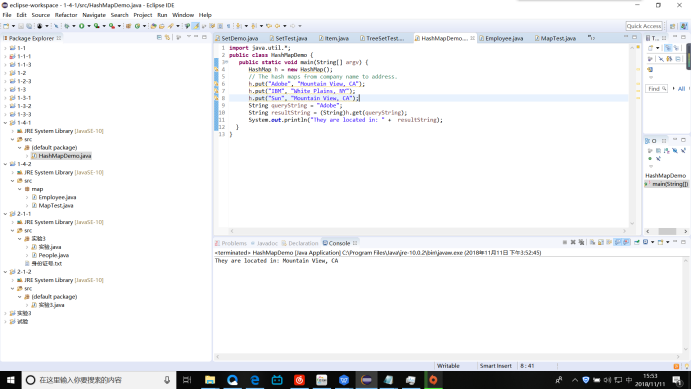
程序9-6:
package map;
/**
* A minimalist employee class for testing purposes.
*/
public class Employee
{
private String name;
private double salary;
/**
* Constructs an employee with $0 salary.
* @param n the employee name
*/
public Employee(String name)
{
this.name = name;
salary = 0;
}
public String toString()
{
return "[name=" + name + ", salary=" + salary + "]";
}
}
package map;
import java.util.*;
/**
* This program demonstrates the use of a map with key type String and value type Employee.
* @version 1.12 2015-06-21
* @author Cay Horstmann
*/
public class MapTest
{
public static void main(String[] args)
{
Map<String, Employee> staff = new HashMap<>();
staff.put("144-25-5464", new Employee("Amy Lee"));
staff.put("567-24-2546", new Employee("Harry Hacker"));
staff.put("157-62-7935", new Employee("Gary Cooper"));
staff.put("456-62-5527", new Employee("Francesca Cruz"));
// print all entries
System.out.println(staff);
// remove an entry
staff.remove("567-24-2546");
// replace an entry
staff.put("456-62-5527", new Employee("Francesca Miller"));
// look up a value
System.out.println(staff.get("157-62-7935"));
// iterate through all entries
staff.forEach((k, v) ->
System.out.println("key=" + k + ", value=" + v));
}
}
测试结果:

实验2:结对编程练习:
l 关于结对编程:以下图片是一个结对编程场景:两位学习伙伴坐在一起,面对着同一台显示器,使用着同一键盘,同一个鼠标,他们一起思考问题,一起分析问题,一起编写程序。
l 关于结对编程的阐述可参见以下链接:
http://www.cnblogs.com/xinz/archive/2011/08/07/2130332.html
http://en.wikipedia.org/wiki/Pair_programming
l 对于结对编程中代码设计规范的要求参考:
http://www.cnblogs.com/xinz/archive/2011/11/20/2255971.html
以下实验,就让我们来体验一下结对编程的魅力。
l 确定本次实验结对编程合作伙伴;
合作伙伴:邹丰蔚
l 各自运行合作伙伴实验九编程练习1,结合使用体验对所运行程序提出完善建议;
合作伙伴的程序:
Main:
package 身份证;
import java.io.BufferedReader;
import java.io.File;
import java.io.FileInputStream;
import java.io.FileNotFoundException;
import java.io.IOException;
import java.io.InputStreamReader;
import java.util.ArrayList;
import java.util.Arrays;
import java.util.Collections;
import java.util.List;
import java.util.Scanner;
public class Main{
private static ArrayList<student> studentlist;
public static void main(String[] args) {
studentlist = new ArrayList<>();
Scanner scanner = new Scanner(System.in);
File file = new File("C:\\Users\\身份证号.txt");
try {
FileInputStream fis = new FileInputStream(file);
BufferedReader in = new BufferedReader(new InputStreamReader(fis));
String temp = null;
while ((temp = in.readLine()) != null) {
Scanner linescanner = new Scanner(temp);
linescanner.useDelimiter(" ");
String name = linescanner.next();
String number = linescanner.next();
String sex = linescanner.next();
String year = linescanner.next();
String province =linescanner.nextLine();
student student = student();
student.setname(name);
student.setnumber(number);
student.setsex(sex);
int a = Integer.parseInt(year);
student.setyear(year);
student.setprovince(province);
studentlist.add(student);
}
} catch (FileNotFoundException e) {
System.out.println("学生信息文件找不到");
e.printStackTrace();
} catch (IOException e) {
System.out.println("学生信息文件读取错误");
e.printStackTrace();
}
boolean isTrue = true;
while (isTrue) {
System.out.println("1.按姓名字典序输出人员信息:");
System.out.println("2.查询最大年龄的人员信息:");
System.out.println("3.查询最小年龄人员信息:");
System.out.println("4.输入你的年龄,查询身份证号.txt中年龄与你最近人的信息:");
System.out.println("5.查询人员中是否有你的同乡:");
int nextInt = scanner.nextInt();
switch (nextInt) {
case 1:
Collections.sort( studentlist);
System.out.println( studentlist.toString());
break;
case 2:
int MAX=0,MIN=100;int j,k1 = 0,k2=0;
for(int i=1;i< studentlist.size();i++)
{
j= studentlist.get(i).getyear();
if(j>MAX)
{
MAX=j;
k1=i;
}
System.out.println("年龄最大:"+ studentlist.get(k1));
}
break;
case 3:
int max=0,min=100;int L,m1 = 0,m2=0;
for(int i=1;i< studentlist.size();i++)
{
L= studentlist.get(i).getyear();
if(L>max)
{
max=L;
m1=i;
}
if(L<min)
{
min=L;
m2=i;
}
}
System.out.println("年龄最小:"+ studentlist.get(m2));
break;
case 4:
System.out.println("province?");
String find = scanner.next();
String province=find.substring(0,3);
String province2=find.substring(0,3);
for (int i = 0; i < studentlist.size(); i++)
{
if( studentlist.get(i).getprovince().substring(1,4).equals(province))
System.out.println(studentlist.get(i));
}
break;
case 5:
System.out.println("年龄:");
int yourage = scanner.nextInt();
int near=yearnear(yourage);
int d_value=yourage-studentlist.get(near).getyear();
System.out.println(""+studentlist.get(near));
/* for (int i = 0; i < Peoplelist.size(); i++)
{
int p=Personlist.get(i).getage()-yourage;
if(p<0) p=-p;
if(p==d_value) System.out.println(Peoplelist.get(i));
} */
break;
case 6:
isTrue = false;
System.out.println("退出程序!");
break;
default:
System.out.println("输入有误");
}
}
}
private static student student() {
// TODO Auto-generated method stub
return null;
}
public static int yearnear(int year) {
int min=25,d_value=0,k=0;
for (int i = 0; i < studentlist.size(); i++)
{
d_value= studentlist.get(i).getyear()-year;
if(d_value<0) d_value=-d_value;
if (d_value<min)
{
min=d_value;
k=i;
}
} return k;
}
}
Student:
package 身份证;
public abstract class student implements Comparable<student> {
private String name;
private String number ;
private String sex ;
private String year;
private String province;
public String getname()
{
return name;
}
public void setName(String name)
{
this.name = name;
}
public String getnumber()
{
return number;
}
public void setnumber(String number)
{
this.number = number;
}
public String getsex()
{
return sex ;
}
public void setsex(String sex )
{
this.sex =sex ;
}
public String getyaer()
{
return year;
}
public void setyear(String year )
{
this.year=year ;
}
public String getprovince()
{
return province;
}
public void setprovince(String province)
{
this.province=province ;
}
public int compareTo(student o)
{
return this.name.compareTo(o.getname());
}
public String toString()
{
return name+"\t"+sex+"\t"+year+"\t"+number+"\t"+province+"\n";
}
public int getyear()
{
// TODO Auto-generated method stub
return 0;
}
public void setname(String name2)
{
// TODO Auto-generated method stub
}
}
测试结果:
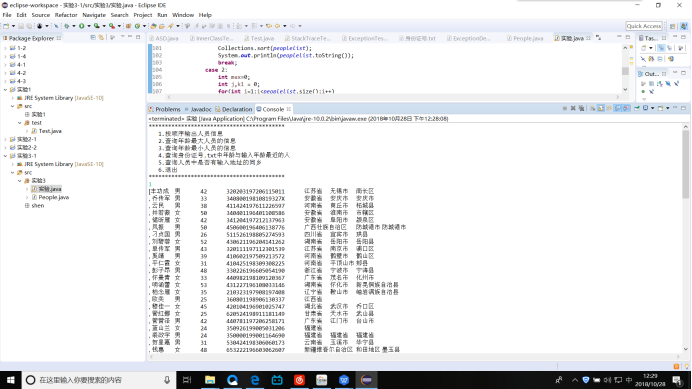
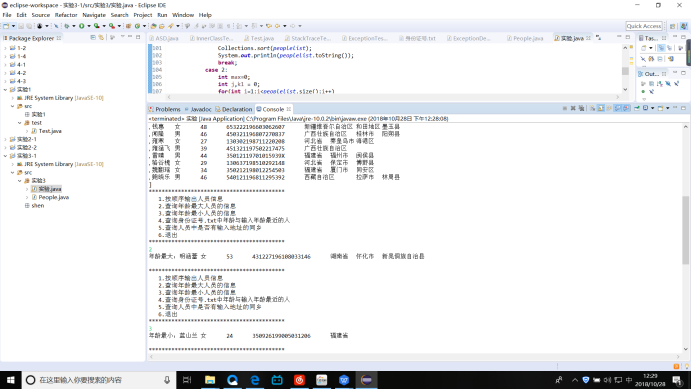
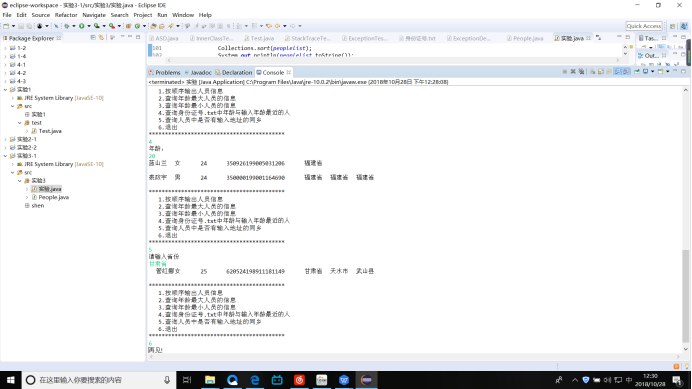
完善建议:
程序运行无明显错误,但程序行与行之间空格太大,显得程序太长,建议再重新将程序排列一下。
l 各自运行合作伙伴实验十编程练习2,结合使用体验对所运行程序提出完善建议;
合作伙伴的程序:
import java.io.FileNotFoundException;
import java.io.PrintWriter;
import java.util.Random;
import java.util.Scanner;
public class Test{
int sum;
public static void main(String[] args) {
Scanner in = new Scanner(System.in);
PrintWriter out = null;
try {
out = new PrintWriter("C:\\Users\\Administrator\\Desktop\\test.txt");
} catch (FileNotFoundException e) {
System.out.println("文件夹输出失败");
e.printStackTrace();
}
Test t=new Test();
System.out.println("本次测试共十道题,每题十分,满分一百分");
t.sum=0;
Random r=new Random();
for(int i=0;i<10;i++) {
t.core();
}
System.out.println("考试结束");
System.out.println("你的总分为"+t.sum);
}
private void core() {
Random r=new Random();
int m,n;
m=r.nextInt(11);
n=m%4;
switch(n) {
case 0:
int a ,b,c;
a=r.nextInt(101);
b=r.nextInt(101);
System.out.println(a+"+"+"("+b+")"+"=");
Scanner x=new Scanner(System.in);
c=x.nextInt();
if(c!=a+b)
System.out.println("回答错误");
else {
System.out.println("回答正确");
sum=sum+10;
}
break;
case 1:
int h,g,f;
h=r.nextInt(101);
g=r.nextInt(101);
System.out.println(h+"-"+"("+g+")"+"= ");
Scanner u=new Scanner(System.in);
f=u.nextInt();
if(f!=h-g)
System.out.println("回答错误");
else {
System.out.println("回答正确");
sum=sum+10;
}
break;
case 2:
int q,w,e;
q=r.nextInt(101);
w=r.nextInt(101);
System.out.println(q+"*"+"("+w+")"+"= ");
Scanner y=new Scanner(System.in);
e=y.nextInt();
if(e!=q*w)
System.out.println("回答错误");
else {
System.out.println("回答正确");
sum=sum+10;
}
break;
case 3:
int j,k,l;
j=r.nextInt(101);
k=r.nextInt(101);
if(k==0)
k++;
System.out.println(j+"/"+"("+k+")"+"= ");
Scanner z=new Scanner(System.in);
l=z.nextInt();
if(l!=(j/k)/1.00)
System.out.println("回答错误");
else {
System.out.println("回答正常");
sum=sum+10;
}
break;
}
}
}
测试结果:
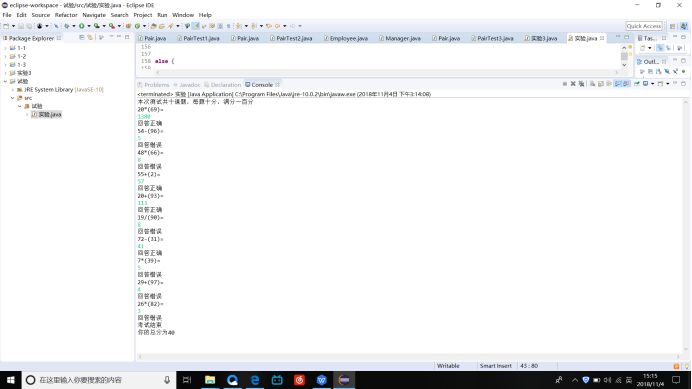

完善建议:
行数太多,但程序总数少,建议简化程序。
l 采用结对编程方式,与学习伙伴合作完成实验九编程练习1;
测试程序:
package 实验3;
import java.io.BufferedReader;
import java.io.File;
import java.io.FileInputStream;
import java.io.FileNotFoundException;
import java.io.IOException;
import java.io.InputStreamReader;
import java.util.ArrayList;
import java.util.Scanner;
import java.util.Collections;
public class 实验 {
public static People findPeopleByname(String name) {
People flag = null;
for (People people : peoplelist) {
if(people.getName().equals(name)) {
flag = people;
}
}
return flag;
}
public static People findPeopleByid(String id) {
People flag = null;
for (People people : peoplelist) {
if(people.getnumber().equals(id)) {
flag = people;
}
}
return flag;
}
private static ArrayList<People> agenear(int yourage) {
// TODO Auto-generated method stub
int j=0,min=53,d_value=0,k = 0;
ArrayList<People> plist = new ArrayList<People>();
for (int i = 0; i < peoplelist.size(); i++) {
d_value = peoplelist.get(i).getage() > yourage ?
peoplelist.get(i).getage() - yourage : yourage - peoplelist.get(i).getage() ;
k = d_value < min ? i : k;
min = d_value < min ? d_value : min;
}
for(People people : peoplelist) {
if(people.getage() == peoplelist.get(k).getage()) {
plist.add(people);
}
}
return plist;
}
private static ArrayList<People> peoplelist;
public static void main(String[] args) {
peoplelist = new ArrayList<People>();
Scanner scanner = new Scanner(System.in);
File file = new File("C:\\Users\\张季跃\\Desktop\\第十周实验报告\\身份证号.txt");
try {
FileInputStream files = new FileInputStream(file);
BufferedReader in = new BufferedReader(new InputStreamReader(files));
String temp = null;
while ((temp = in.readLine()) != null) {
String[] information = temp.split("[ ]+");
People people = new People();
people.setName(information[0]);
people.setnumber(information[1]);
int A = Integer.parseInt(information[3]);
people.setage(A);
people.setsex(information[2]);
for(int j = 4; j<information.length;j++) {
people.setplace(information[j]);
}
peoplelist.add(people);
}
} catch (FileNotFoundException e) {
System.out.println("文件未找到");
e.printStackTrace();
} catch (IOException e) {
System.out.println("文件读取错误");
e.printStackTrace();
}
boolean isTrue = true;
while (isTrue) {
System.out.println("******************************************");
System.out.println(" 1.按顺序输出人员信息");
System.out.println(" 2.查询年龄最大人员的信息");
System.out.println(" 3.查询年龄最小人员的信息");
System.out.println(" 4.查询身份证号.txt中年龄与输入年龄最近的人");
System.out.println(" 5.查询人员中是否有输入地址的同乡");
System.out.println(" 6.退出");
System.out.println("******************************************");
int nextInt = scanner.nextInt();
switch (nextInt) {
case 1:
Collections.sort(peoplelist);
System.out.println(peoplelist.toString());
break;
case 2:
int max=0;
int j,k1 = 0;
for(int i=1;i<peoplelist.size();i++)
{
j = peoplelist.get(i).getage();
if(j>max)
{
max = j;
k1 = i;
}
}
System.out.println("年龄最大:"+peoplelist.get(k1));
break;
case 3:
int min = 100;
int j1,k2 = 0;
for(int i=1;i<peoplelist.size();i++)
{
j1 = peoplelist.get(i).getage();
if(j1<min)
{
min = j1;
k2 = i;
}
}
System.out.println("年龄最小:"+peoplelist.get(k2));
break;
case 4:
System.out.println("年龄:");
int input_age = scanner.nextInt();
ArrayList<People> plist = new ArrayList<People>();
plist = agenear(input_age);
for(People people : plist) {
System.out.println(people.toString());
}
break;
case 5:
System.out.println("请输入省份");
String find = scanner.next();
for (int i = 0; i <peoplelist.size(); i++)
{
String [] place = peoplelist.get(i).getplace().split("\t");
for(String temp : place) {
if(find.equals(temp)) {
System.out.println(" "+peoplelist.get(i));
break;
}
}
}
break;
case 6:
isTrue = false;
System.out.println("再见!");
break;
default:
System.out.println("输入有误");
}
}
}
}
package 实验3;
public class People implements Comparable<People> {
private String name = null;
private String number = null;
private int age = 0;
private String sex = null;
private String place = null;
public String getName()
{
return name;
}
public void setName(String name)
{
this.name = name;
}
public String getnumber()
{
return number;
}
public void setnumber(String number)
{
this.number = number;
}
public int getage()
{
return age;
}
public void setage(int age )
{
this.age = age;
}
public String getsex()
{
return sex;
}
public void setsex(String sex )
{
this.sex = sex;
}
public String getplace()
{
return place;
}
public void setplace(String place)
{
if(this.place == null) {
this.place = place;
}else {
this.place = this.place+ "\t" +place;
}
}
public int compareTo(People o)
{
return this.name.compareTo(o.getName());
}
public String toString()
{
return name+"\t"+sex+"\t"+age+"\t"+number+"\t"+place+"\n";
}
}
实验结果:
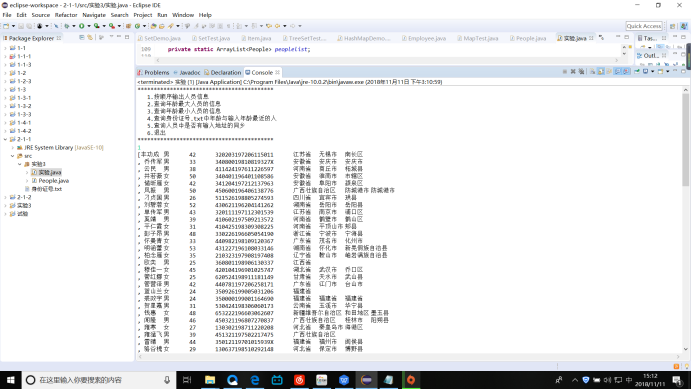
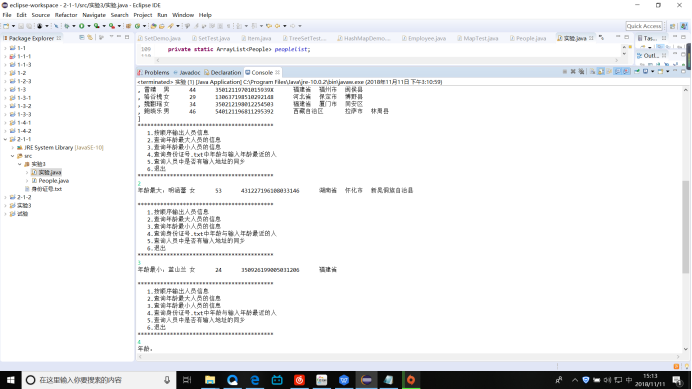
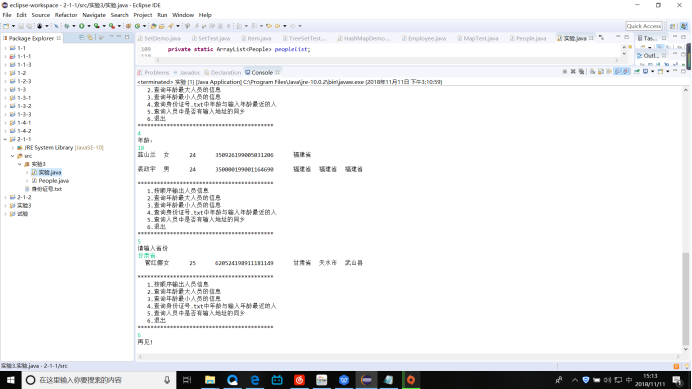
l 采用结对编程方式,与学习伙伴合作完成实验十编程练习2。
测试程序:
import java.util.Random;
import java.util.Scanner;
public class 实验3{
int sum;
public static void main(String[] args) {
实验3 t=new 实验3();
System.out.println("考试开始");
t.sum=0;
Random r=new Random();
for(int i=0;i<10;i++) {
t.core();
}
System.out.println("考试结束");
System.out.println("你的总分为"+t.sum);
}
private void core() {
Random r=new Random();
int m,n;
m=r.nextInt(11);
n=m%4;
switch(n) {
case 0:
int a ,b,c;
a=r.nextInt(101);
b=r.nextInt(101);
System.out.println(a+"+"+"("+b+")"+"=");
Scanner x=new Scanner(System.in);
c=x.nextInt();
if(c!=a+b)
System.out.println("计算失误");
else {
System.out.println("计算正确");
sum=sum+10;
}
break;
case 1:
int h,g,f;
h=r.nextInt(101);
g=r.nextInt(101);
System.out.println(h+"-"+"("+g+")"+"= ");
Scanner u=new Scanner(System.in);
f=u.nextInt();
if(f!=h-g)
System.out.println("计算失误");
else {
System.out.println("计算正确");
sum=sum+10;
}
break;
case 2:
int q,w,e;
q=r.nextInt(101);
w=r.nextInt(101);
System.out.println(q+"*"+"("+w+")"+"= ");
Scanner y=new Scanner(System.in);
e=y.nextInt();
if(e!=q*w)
System.out.println("计算失误");
else {
System.out.println("计算正确");
sum=sum+10;
}
break;
case 3:
double j,k,l;
j=r.nextInt(101);
k=r.nextInt(101);
if(k==0)
k++;
System.out.println(j+"/"+"("+k+")"+"= ");
Scanner z=new Scanner(System.in);
l=z.nextDouble();
if(l!=(j/k)/1.00)
System.out.println("计算失误");
else {
System.out.println("计算正确");
sum=sum+10;
}
break;
}
}
}
实验结果:


第三部分:实验总结:
这一周我主要学习了Java中的数据结构和Java中有关集合的知识,通过和数据结构可的相互验证,关于Java中的数据结构我有了初步的了解,但对于集合我感觉还是有不会的东西需要请教同学,而且,这一周通过结对编程练习,我对于前几周编写的程序有了更深入的了解,巩固了以前学习的知识。



